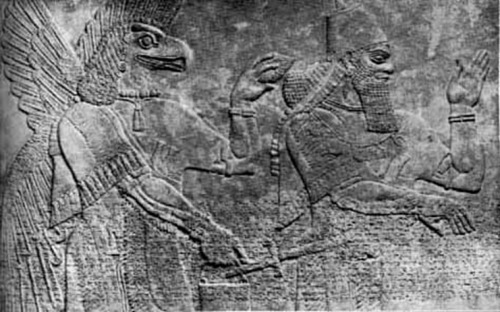Lenzi: The Uruk List of Kings and Sages Renewed the Anu Cult
“Whatever the first word may be, I think van Dijk was correct to suggest that the name of the final person in the list, a certain Ini-qa-qu-ru-sù-ú, is none other than the Nikarchos (Νίκαρχος) known from the dedicatory inscription found in the Bīt Rēs temple dating back to 244 BCE.
Although some have questioned this proposed identification due to the orthography of the name on the tablet, variations in Greek names are rather common.
Indeed, a list of orthographic variations attested for Nikarchos in archival texts, provided to me by L. T. Doty, suggests his name was something of a moving target for the scribes. Thus, the identification seems quite plausible. This in turn opens line 21 to an interesting line of interpretation.
I suggest that Nikarchos, the šaknu of Uruk in the mid-3rd Century, occupies in line 21 the position of the tenth and final “king” of the ULKS.
(Nikarchos is clearly not listed as a king; notice the absence of LUGAL after his name. My interpretation suggests the placement in the text was a symbolic gesture. Although Nikarchos was a member of the Ahu’tu clan, his work on the temple would have benefited all of the scribal clans.

Ruins of the Anu Ziggurat and the White Temple. Uruk ( Present-day Warka, Iraq). c. 3300-3000 BCE.
https://www.pinterest.com/pin/168814686005734256/
It is therefore not surprising to see a text with a Sin-leqi-unnini bias honor him as the ULKS does. Van Dijk accepted the identification of the name with Nikarchos tentatively; but, having confused Nikarchos for Kephalon in the dedicatory inscription of 201 BCE mentioned above, he wanted to make Nikarchos the last of a long line of sage/scholars that stretched back to Adapa. Apart from the confusion, I do not think the list supports this idea.)
Associating him with ancient kings of renown and doing so by listing him in the tenth (a number of completion) and final (a place of prominence) position in the list exalts him well-beyond what one would expect from his actual civic title.
As is well-known, temple building was a royal prerogative in ancient Mesopotamia and Nikarchos had shown leadership in the re-building of the Anu temple as indicated in the dedicatory inscription of 244 BCE. The presentation here therefore is probably intended to praise and flatter Nikarchos in light of his king-like actions.
Yet there is something amiss in our line; it is uneven and unprecedented. For unlike the kings listed in the lines before Nikarchos, no scholar’s name follows his on the tablet. There is no successor to the famed Ahiqar.
Instead, there is a gap on the tablet to the end of the line. Conspicuous in its contrast to the repetitive lines that precede, the text infers with this absence that the office of scholar was unoccupied during Nikarchos’ time.
(If there had been a scholar named with Nikarchos, he would have been the eleventh post-diluvian scholar on the list since there are two scholars, Gimil-Gula and Taqiš-Gula, mentioned with king Abi-ešuh in line 15.
But as there are only nine post-diluvian kings in the list, Nikarchos’s scholar would be the scholar for the tenth reign. Excluding the invocation attached to the end of the tablet (line 25), the gap at the end of line 21 is the only one on the entire tablet.)
Given the norm established by the previous lines in the text, this should be viewed as an unacceptable situation for the scholars in Uruk. Contemporary scholars, the list implies, were not being properly recognized; they were not receiving their ancient due.
How could scholars respond to this situation? They did what they knew to do: they wrote a text—our text—to assert emphatically their ancient role as inheritors and perpetuators of antediluvian knowledge, to lay claim unmistakably to divine authorization of their status, and to reiterate in strong terms the importance and supremacy of their cult.
Ending as it does with Nikarchos, the text flatters the man to which they could appeal while also reminding him of the current deficiency. The scholars knew that Nikarchos was not really a king. Further, they of all people would be aware of the fact that they were not going to be imperial advisors like their predecessors to him or to the non-indigenous Seleucid kings.
But the text’s ending praises their patron for his past activity in order to induce him to take up their cause and give them the attention their ancient pedigree deserved. If imperial interests in Uruk were on the wane, Nikarchos may have been their only and best hope to further their interests.
The ULKS presents a new formulation of an old scribal genealogical idea, composed under foreign rule that showed uneven interest in things Mesopotamian, during a scribal renaissance in Uruk of archaic indigenous lore.
From these historical contextual clues it is reasonable and plausible to suggest that the Uruk List of Kings and Sages is a tendentious document written by scholars who felt the need to reassert their importance to the community leadership in order to advance their cause, the renewal of the Anu cult.
Recognizing the tentativeness of the evidence, this interpretation remains only a possibility for the time being.”
Alan Lenzi, The Uruk List of Kings and Sages and Late Mesopotamian Scholarship, JANER 8.2, Brill, Leiden, 2008. pp. 163-5.


